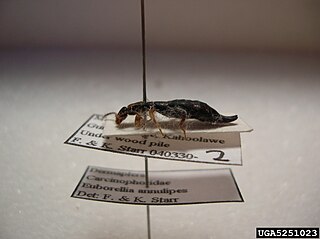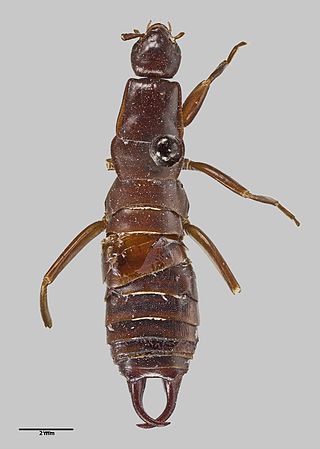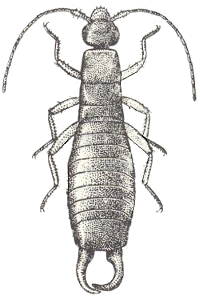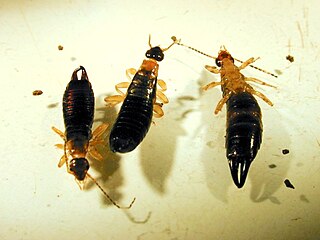
Pygidicranidae is a family of earwigs, formerly placed in the suborder Forficulina, now in the suborder Neodermaptera. The family currently contains twelve subfamilies and twenty six genera. Eight of the subfamilies are monotypic, each containing a single genus. Of the subfamilies, both Astreptolabidinae and Burmapygiinae are extinct and known solely from fossils found in Burmese amber. Similarly Archaeosoma, Gallinympha, and Geosoma, which have not been placed into any of the subfamilies, are also known only from fossils. Living members of the family are found in Australia, South Africa, North America, and Asia. The monotypic genus Anataelia, described by Ignacio Bolivar in 1899, is found only on the Canary Islands. As with all members of Neodermaptera, pygidicranids do not have any ocelli. The typical pygidicranid bodyplan includes a small, flattened-looking body, which has a dense covering of bristly hairs (setae). The pair of cerci at the end of the abdomen are symmetrical in structure. The head is broad, with the fourth, fifth and sixth antenna segments (antennomeres) that are not transverse. In general Pygidicranids also have equally sized ventral cervical sclerites, and in having the rearmost sclerite separated from, or only touching the center of the prosternum. Cannibalism of young has been observed in at least one species in the family, Challia hongkongensis, in which an adult female was found eating a still-living nymph of the same species. The same species in a different area has been observed possibly eating fruits or seeds, making the species an omnivore.

Forficulidae is a family of earwigs in the order Dermaptera. There are more than 70 genera and 490 described species in Forficulidae.

Anisolabididae is a family of earwigs, in the suborder Forficulina and the order Dermaptera. It is one of nine families in the suborder Forficulina, and contains thirty-eight genera spread across thirteen subfamilies.

Anisolabidinae, alternatively known as Carcinophorinae, Gonolabiinae, Placolabidinae, or Titanolabiinae, is a subfamily of earwigs that contains approximately twenty-five genera. Its existence was cited by Srivastava in the book Fauna of India Pt. 2, by Chen & Ma in Fauna Sinica, and by Henrik Steinmann in The Animal Kingdom. Although Steinmann cited the subfamily's name as Carcinophorinae, this is a synonym for the taxon.

Brachylabinae is a subfamily of earwigs, and contains three genera. Ctenisolabis and Metisolabis were cited by both Steinmann and Srivastava, while Brachylabis were cited by Steinmann, Srivastava, and Chen & Ma.

Anisolabis is a genus of mostly Asian earwigs in the subfamily Anisolabidinae. It was cited by Srivastava in Part 2 of Fauna of India. The name Anisolabis stems from the asymmetry of the male cerci; the right cercus being more acute than the left.
Ctenisolabis is a genus of earwigs in the subfamily Brachylabinae. It was cited by Srivastava in Part 2 of Fauna of India. It was also cited at an earlier date by Steinmann in his publication, The Animal Kingdom in 1986, 1989, 1990, and 1993.

Euborellia is a genus of earwigs in the subfamily Anisolabidinae. This genus, which has a world-wide distribution, was erected by Malcolm Burr in 1909 and was cited by Srivastava in Part 2 of Fauna of India.

Gonolabis is a genus of earwigs in the subfamily Anisolabidinae. It was cited by Srivastava in Part 2 of Fauna of India.
Platylabia is a genus of earwigs, the sole member of the subfamily Platylabiinae. It was cited by Srivastava in Part 2 of Fauna of India. It was also cited at an earlier date by Steinmann in his publication, The Animal Kingdom in 1986, 1989, 1990, and 1993, and by Chen & Ma in Fauna Sinica in 2004.

Titanolabis is a genus of earwigs in the subfamily Anisolabidinae. It was cited by Srivastava in Part 2 of Fauna of India. Among its species is the Australian T. colossea, which at about 5 cm (2.0 in) long is the largest certainly living species of earwig.
This taxonomy of the Dermaptera follows Engel & Haas (2007) to the rank of Tribe.

Spongiphoridae is a family of little earwigs in the suborder Neodermaptera. There are more than 40 genera and 510 described species in Spongiphoridae.

Opisthocosmiinae is a subfamily of earwigs in the family Forficulidae. There are about 18 genera and more than 100 described species in Opisthocosmiinae.
Skendylinae is a subfamily of earwigs in the family Forficulidae. There are about 12 genera and more than 60 described species in Skendylinae.
Irdex is a genus of earwigs belonging to the subfamily Spongiphorinae.
Echinosoma is a genus of earwigs in the family Pygidicranidae, erected by Audinet-Serville in 1838.
Haplodiplatys is a genus of Asian earwigs erected by Walter Douglas Hincks in 1955. It is the only member of the monotypic family Haplodiplatyidae, with many species originally placed in the genus Diplatys; a key to them was prepared by Alan Brindle.
Diplatys is a genus of Asian earwigs, in the family Diplatyidae, erected by Jean Guillaume Audinet-Serville in 1831. The recorded distribution of species is from Indochina, although this may be incomplete; it is also worth noting that other genera in subfamily Diplatyinae and the genus Haplodiplatys historically have been placed here.









